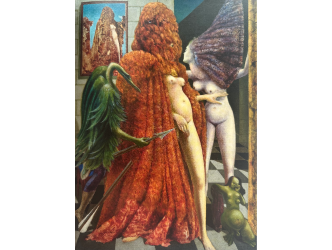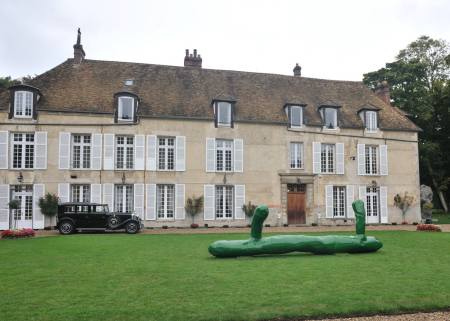Erudition and execution
“The act of painting is the longest and the most difficult. You need the erudition of a composer, but also the execution required to play the violin.” Eugène Delacroix wrote these words in 1847 and nearly 170 years later this observation from the man who produced “La mort de Sardanapale” still holds true. We become aware of this in the presence of a contemporary artist who lives between Japan and Paris, Lee Ufan (born in 1936). It takes time to truly understand his work.
Kamakura

I have interviewed him on many occasions (see here and here), but it was not until I met him at his home in Kamakura on the outskirts of Tokyo that I began to really get a glimpse of the mystery of his creation. Each new glimpse is a new step. He has lived here for 40 years, next to a forest and not far from the sea, in this town known for its numerous temples, in an unostentatious house. Outside there is a small garden dotted with several sculptures that serve as models for his three-dimensional works. The Japanese sun, strangely strong for the month of December, shines through into the studio space.
As humble as ever
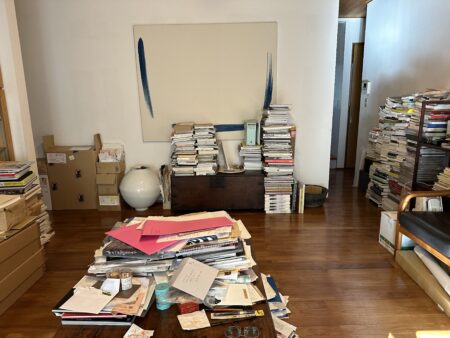
He has come to meet me at the entrance. Just as humble as ever. We start by drinking tea and eating candied chestnuts in the Japanese way. He is accompanied by his daughter Mina, a university art professor, and by a translator, because he is not entirely confident in his English.
Kobe
Following a retrospective in Tokyo, his work can be seen until 12 February in Kobe at the Hyogo Prefectural Museum of Art, whose building was designed by Tadao Ando (https://www.artm.pref.hyogo.jp/eng/exhibition/). The marriage of Ando’s lines and those of Lee work together perfectly. The exhibition is very beautiful. It also allows us to see lesser-known artworks such as the fluorescent monochrome red paintings from 1968, which also open the show under the title “Landscape”.
Tension
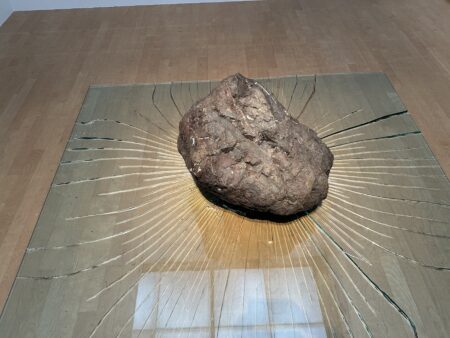
For a long time his work has generally addressed the subject of tension: tension between stone and metal, conceived as the product of nature in opposition to the product of man, but also the tension between fullness and emptiness, or the motif of the brushstroke against the white of the paper or canvas. We can apply this analogical thinking to suggest that Lee Ufan’s life itself is the expression of a certain tension, the artist who has lived in Japan since the age of 20, a country that was in the past the enemy of his original culture.
Bridge
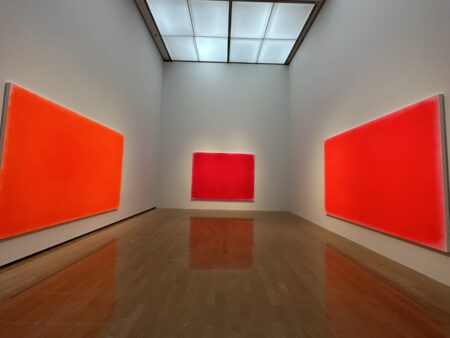
But that day, speaking to Lee Ufan in an intimate setting, sitting on tatami mats, led to the realization that his creation is a bridge between Western and Eastern culture. Even if he claims not to have this aim in mind.
Tadashi Kobayashi
“Mr Lee has lived through, in the first part of the 20th century, major conflicts in the world. I think he has disregarded these issues,” judiciously observes the curator at the Kobe museum, Tadashi Kobayashi.
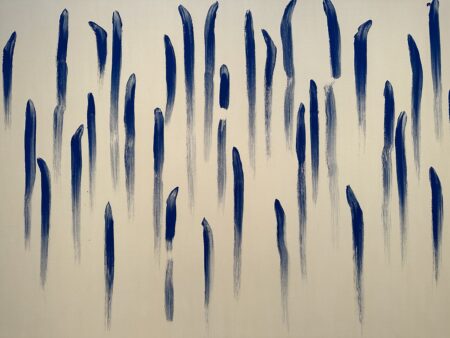
At his studio, the artist is surrounded by books on Matisse, Land Art, Beuys and some African statues. “What fascinates me so much about African art is that in it I can really feel in this objects the concept of life and death,” he explains. In fact, Lee Ufan is inspired beyond borders, with a Korean and Japanese education combined with Western influences such as Barnett Newman, for example.
Barnett Newman
He says: “In 1971 I travelled from Paris to New York. At the time, especially in Europe, they were all talking about the end of painting, so painting wasn’t really a contemporary art source anymore. But then I went to the Moma in New York and there was an exhibition by Barnett Newman where there were all these large black and white paintings. The artist was really taking in the idea of space in these paintings. So upon returning to Japan I was thinking about all the practices when I was a little kid, all these dots and lines that you would practice over and over, and I thought that would be able to express the concept of time.
Points and lines
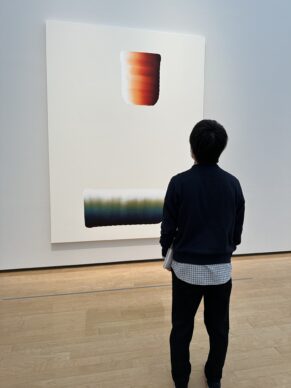
I started to create these points and lines. I would apply the paint with a brush but over time I would use the same brush, so the paint would get less and less, each point, each line would get less and less thick. A sort of a system to express the idea of time”. The following observations reveals how his work also addresses the relationship with his body: “in the 80s my body started becoming unable to keep up with this system, to do almost this machine-like repetitive work. So whenever I was trying to work on a painting, I would get shivers and I wouldn’t be able to paint.
How my body acts
Physicality, how my body acts, is really important in my works. So in the 1990s I tried to make less strokes. You have this space of what’s being drawn and what’s not being drawn. Each stroke becomes more and more important. I did a lot of research and I found out that breathing is very important. Slowly inhaling while putting down the brushstrokes, and finding out how to make the best strokes, the most beautiful strokes… It’s about creating the relationships between the stroke and what’s not the stroke, so seeing what’s the vibration, what’s the combination, and what kind of space it creates”.
On the ground

To paint, Lee Ufan places the canvas on the ground and holds his breath while making the brushstroke, for up to two minutes. This breath-holding exercise is perfected using a very large paintbrush, which he had made specially in France, as shown in the video. This period of retrospectives is also, for Lee Ufan, one of looking back over his work. “In looking at my paintings and my sculpture: I really was thinking of this idea of, to make but also of not to make. The ideas of docking something made and something not made by humans. I feel that this concept was really correct.”
In Arles
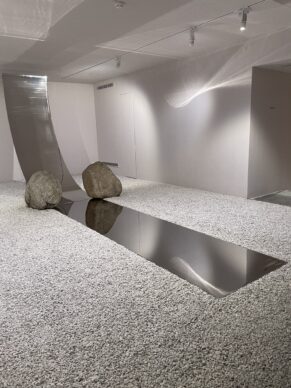
After having opened a museum dedicated to him in Naoshima in 2010, on the Benesse Island in Japan( See the report about Naoshima here), a few months ago Lee Ufan also inaugurated a foundation of another kind in the South of France in Arles, in a Provencal “hôtel particulier”. “My galleries recommended that I open a foundation in New York. But Arles is a really nice mix of old and new, it’s quiet, it’s not noisy, and there’s a lot of history and culture, a very nice combination between the two, just like how we are here in Kamakura. I felt that that really fit me.”
The Korean artist who lives in Japan has pinned his legacy to the land of Van Gogh, not far from the light of Cézanne.
Erudition and execution
“The act of painting is the longest and the most difficult. You need the erudition of a composer, but also the execution required to play the violin.” Eugène Delacroix wrote these words in 1847 and nearly 170 years later this observation from the man who produced “La mort de Sardanapale” still holds true. We become aware of this in the presence of a contemporary artist who lives between Japan and Paris, Lee Ufan (born in 1936). It takes time to truly understand his work.
Kamakura

I have interviewed him on many occasions( see here and here), but it was not until I met him at his home in Kamakura on the outskirts of Tokyo that I began to really get a glimpse of the mystery of his creation. Each new glimpse is a new step. He has lived here for 40 years, next to a forest and not far from the sea, in this town known for its numerous temples, in an unostentatious house. Outside there is a small garden dotted with several sculptures that serve as models for his three-dimensional works. The Japanese sun, strangely strong for the month of December, shines through into the studio space.
As humble as ever

He has come to meet me at the entrance. Just as humble as ever. We start by drinking tea and eating candied chestnuts in the Japanese way. He is accompanied by his daughter Mina, a university art professor, and by a translator, because he is not entirely confident in his English.
Kobe
xxx
Following a retrospective in Tokyo, his work can be seen until 12 February in Kobe at the Hyogo Prefectural Museum of Art, whose building was designed by Tadao Ando (https://www.artm.pref.hyogo.jp/eng/exhibition/). The marriage of Ando’s lines and those of Lee work together perfectly. The exhibition is very beautiful. It also allows us to see lesser-known artworks such as the fluorescent monochrome red paintings from 1968, which also open the show under the title “Landscape”.
Tension

For a long time his work has generally addressed the subject of tension: tension between stone and metal, conceived as the product of nature in opposition to the product of man, but also the tension between fullness and emptiness, or the motif of the brushstroke against the white of the paper or canvas. We can apply this analogical thinking to suggest that Lee Ufan’s life itself is the expression of a certain tension, the artist who has lived in Japan since the age of 20, a country that was in the past the enemy of his original culture.
Bridge

But that day, speaking to Lee Ufan in an intimate setting, sitting on tatami mats, led to the realization that his creation is a bridge between Western and Eastern culture. Even if he claims not to have this aim in mind.
Tadashi Kobayashi
“Mr Lee has lived through, in the first part of the 20th century, major conflicts in the world. I think he has disregarded these issues,” judiciously observes the curator at the Kobe museum, Tadashi Kobayashi.

At his studio, the artist is surrounded by books on Matisse, Land Art, Beuys and some African statues. “What fascinates me so much about African art is that in it I can really feel in this objects the concept of life and death,” he explains. In fact, Lee Ufan is inspired beyond borders, with a Korean and Japanese education combined with Western influences such as Barnett Newman, for example.
Barnett Newman
He says: “In 1971 I travelled from Paris to New York. At the time, especially in Europe, they were all talking about the end of painting, so painting wasn’t really a contemporary art source anymore. But then I went to the Moma in New York and there was an exhibition by Barnett Newman where there were all these large black and white paintings. The artist was really taking in the idea of space in these paintings. So upon returning to Japan I was thinking about all the practices when I was a little kid, all these dots and lines that you would practice over and over, and I thought that would be able to express the concept of time.
Points and lines

I started to create these points and lines. I would apply the paint with a brush but over time I would use the same brush, so the paint would get less and less, each point, each line would get less and less thick. A sort of a system to express the idea of time”. The following observations reveals how his work also addresses the relationship with his body: “in the 80s my body started becoming unable to keep up with this system, to do almost this machine-like repetitive work. So whenever I was trying to work on a painting, I would get shivers and I wouldn’t be able to paint.
How my body acts
Physicality, how my body acts, is really important in my works. So in the 1990s I tried to make less strokes. You have this space of what’s being drawn and what’s not being drawn. Each stroke becomes more and more important. I did a lot of research and I found out that breathing is very important. Slowly inhaling while putting down the brushstrokes, and finding out how to make the best strokes, the most beautiful strokes… It’s about creating the relationships between the stroke and what’s not the stroke, so seeing what’s the vibration, what’s the combination, and what kind of space it creates”.
On the ground

To paint, Lee Ufan places the canvas on the ground and holds his breath while making the brushstroke, for up to two minutes. This breath-holding exercise is perfected using a very large paintbrush, which he had made specially in France, as shown in the video. This period of retrospectives is also, for Lee Ufan, one of looking back over his work. “In looking at my paintings and my sculpture: I really was thinking of this idea of, to make but also of not to make. The ideas of docking something made and something not made by humans. I feel that this concept was really correct.”
In Arles

After having opened a museum dedicated to him in Naoshima in 2010, on the Benesse Island in Japan( See the report about Naoshima here), a few months ago Lee Ufan also inaugurated a foundation of another kind in the South of France in Arles, in a Provencal “hôtel particulier”. “My galleries recommended that I open a foundation in New York. But Arles is a really nice mix of old and new, it’s quiet, it’s not noisy, and there’s a lot of history and culture, a very nice combination between the two, just like how we are here in Kamakura. I felt that that really fit me.”
The Korean artist who lives in Japan has pinned his legacy to the land of Van Gogh, not far from the light of Cézanne.
Support independent news on art.
Your contribution : Make a monthly commitment to support JB Reports or a one off contribution as and when you feel like it. Choose the option that suits you best.
Need to cancel a recurring donation? Please go here.
The donation is considered to be a subscription for a fee set by the donor and for a duration also set by the donor.

